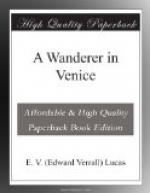A fondamenta runs right away from the Rialto bridge to a point just beyond the new fish market, with some nice houses on it, over shops, the one on the left of the fish market having very charming windows. The first palace of any importance is the dull red one on the other side of the Calle dei Botteri, the Dona. Then a decayed palace and the Calle del Campanile where the fondamenta ends. Here is the very attractive Palazzo Morosini, or Brandolin, which dates from the fourteenth century. Next is a dull house, and then a small one with little lions on the balustrades, and then the Rio S. Cassiano. Next is a tiny and very ancient palace with an inscription stating that the Venetian painter Favretto worked there; then a calle, and the great pawnshop of Venice, once the Palazzo Corner della Regina, is before us, with a number of its own boats inside the handsome blue municipal posts with S. Mark’s lion on each. The Queen of Cyprus was born here; other proud and commanding Corners were splendid here; and now it is a pawnshop!
The Calle della Regina, two rather nice, neglected houses (the little pink one quite charming), and we come to the Rio Pesaro and the splendid Palazzo Pesaro, one of the great works of Longhena. Note its fluted pillars and rich stonework. This palace we may enter, for it is now the Tate Gallery of Venice, housing, below, a changing exhibition of contemporary art, and, above, a permanent collection, to which additions are constantly being made, of modern Italian painting. Foreign artists are admitted too, and my eyes were gladdened by Mr. Nicholson’s “Nancy,” a landscape by Mr. E.A. Walton, a melon-seller by Mr. Brangwyn, a lady in pink by Mr. Lavery, and a fisherman by Mr. Cayley Robinson. A number of Whistler’s Venetian etchings may also be seen here, and much characteristic work by Mr. Pennell. Here too are the “Burghers of Calais” and the “Thinker” of Rodin, while a nude by Fantin Latour should be sought for. One of the most interesting pictures so far as subject goes represents the bridge of boats to the Redentore on a recent All Souls’ day.
I have been absolutely alone in this building, save for the custodians. The Venetian can live very easily without picture galleries, ancient or modern.
The Rio della Pergola washes the other side of the Pesaro palace, and then come two or three houses, once Foscarini homes, given up to antiquity dealers, and then the florid white stone facade of the church of S. Stae (or S. Eustachio) with a delightful little Venetian-red annex on the left. There is a campo and steamboat station here too. The next palace has pretty little Gothic windows, and then a small brown house stands in its garden on the site of a burnt Contarini palace. A good red brick fifteenth-century palace, now a wine store, is next, and then the Tron, now an institution, with a garden and well-head seen through the open door. Great scenes have been witnessed in this building, for the Trons were a famous and powerful Venetian family, supplying more than one Doge, and here in 1775 was entertained the Emperor Joseph II.




